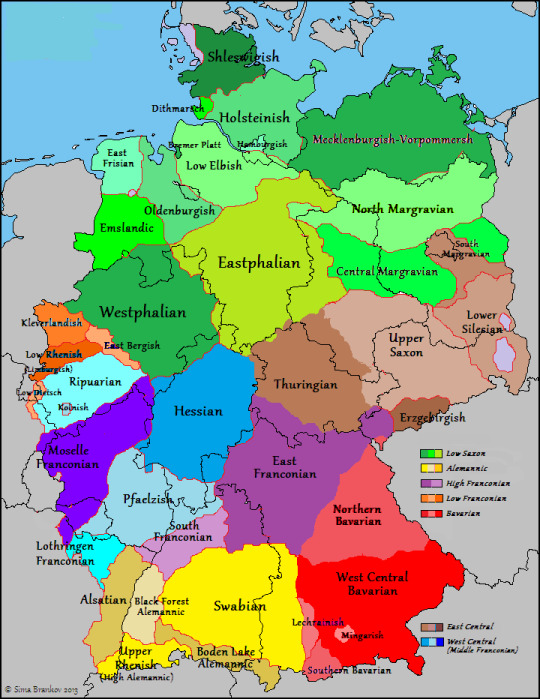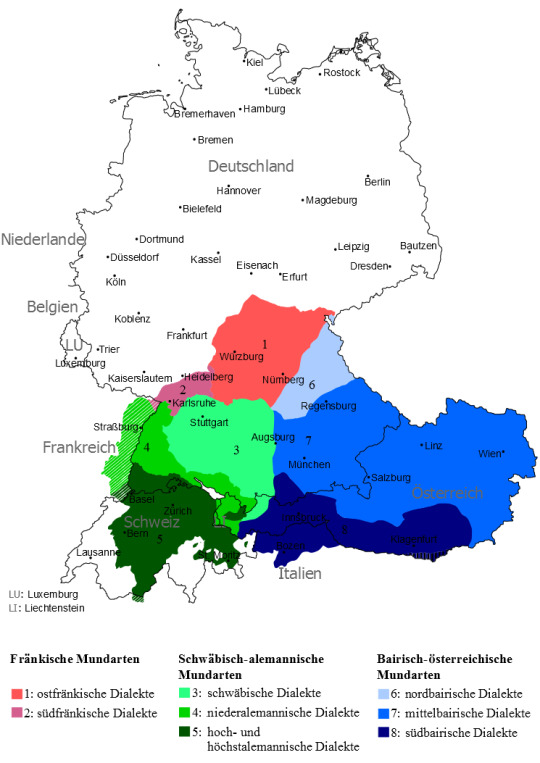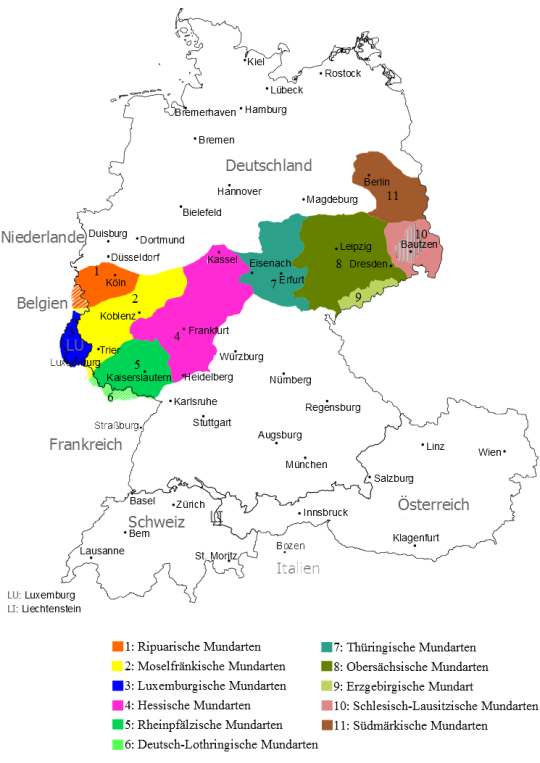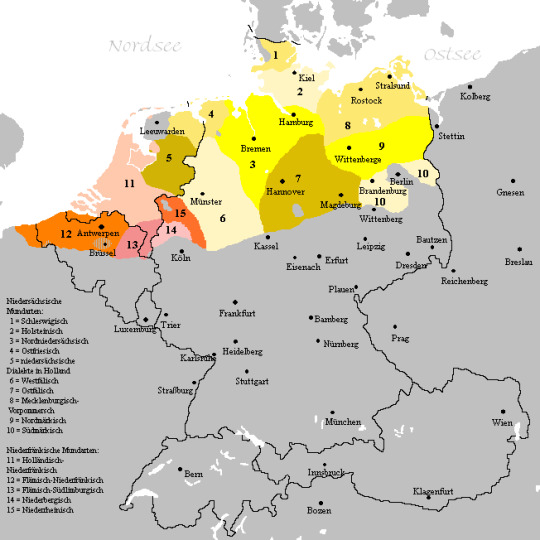#plattdütsch
Explore tagged Tumblr posts
Text
Platt up Zack
#Platt up Zack, Improtheater up #plattdütsch #Emlichheim - Haus Ringerbrüggen, Freitag, 13. Sept. - 20 Uhr, Karten im VVK 9,50 Euro
Platt up Zack Improtheater up plattdütsch Emlichheim – Haus Ringerbrüggen, Rathausstraße 6 Freitag, 13. Sept. – 20 Uhr Karten: 9,50 € im VVK Nach der Sommerpause präsentiert Platt up Zack am 13. September Improtheater up plattdütsch. Seit mehr als 15 Jahren schlüpfen die Darsteller von Platt up Zack spontan in die vom Publikum vorgegebene Situation. Es kann vorkommen, dass sie auf einem…

View On WordPress
#Emlichheim#Gerlinde Schmidt-Hood#Gero Hüsemann#Haus Ringerbrücken#Helmut Treustedt#Karin Tallen#Manuela van Greuningen#Platt#Platt Up Zack#plattdütsch#Simone Wrede#Stefanie Havermann
0 notes
Note
Assumption: you like dead people drama and know 3? languages (cool)
Dear Anon,
yes, I can not deny it, I do like dead people – and their drama. In fact, the older the better. While La Fayette, Pitt the Younger, George IV and the likes are interesting characters, “dead people” like Lucy or the first family probably interest me even more.
As to languages, I speak three languages (four if you count Plattdütsch :-)), as you assumed, and I have a decent enough understanding of five (six) languages. I am not necessarily someone to whom languages come easily but it is such a great experience to interact with people via their own languages and to experience a different culture with the help of a language.
4 notes
·
View notes
Text
Hey I just thought
Isn't growing sideways queer
And isn't a combination of width and altitude what makes one a self?
And isn't it then up to oneself whether one only looks for height or also moves left and right and back and forth, maybe also buptying over the dancefloor?🪩🌊
I put forth that sideways growth also makes for the affective richness that counteracts straightening
So what does growing sideways mean to you? Can the monster grow sideways too? Maybe it would have fun and would not be so angry
Maybe the monster is a misunderstold creature (spelling mistake intended here)
Who tells what about it? And has it ever told anybody anything about why it's so angry? What pronouns does it use? How does it talk.? Bavarian? Plattdütsch? Düsseldorfer Platt?
0 notes
Note
Oh surely friesian does count! It sounds so cool. Never thought this was something they would teach at school/ uni though. It's great! Would be a shame if these old languages would die (my grandparents were talking plattdütsch, us kids hardly undertood anything and they literally switched to it when we were not meant to know)...
🌵
Something i'm learning (about) right now... Shibari. For Under Orders purposes...
And I'm always learning things on piano.
AND! Idk if this counts but when I go back to uni in september I'll be learning Frisian, and I can't fucking wait!!!!
11 notes
·
View notes
Photo

Billerraadel: Wat is dat? ??? Nee! ?? Nee un nee! ? . . . . Denn will ik dat mal seggen: . . . Utwuschen Kalk un Salpeter... ... Bilderrätsel: Was ist das? Nein! Nein und nein! Dann will ich auflösen: Ausgewaschener Kalk und Salpeter. #kalkauswaschung #salpeter #dichtbeibesehen #genauhinsehen #plattdeutsch #plattdüütsch #plattdütsch #platt (hier: Bismarckturm Itzehoe) https://www.instagram.com/p/COUr7tJHKtW/?igshid=p3vjpynko1qf
37 notes
·
View notes
Text
Wi schenkt uns nix
Luise Ortlieb
1 So kort vör’t Fest üm diesse Tiet is dat mit Vadder denn sowiet: He, de so fründlich un so goot, kreeg woll’n Stich un warrt marod vun all dat Neonlichtgetüdel un vun de Swindsucht in sien Büdel un seggt to Mudder füünschen Blicks: “Wi schenkt uns nix!”
2 Un Mudder, ok al half verdreiht, seggt to de Gör’n, de lurig steiht, üm hier un dar en söten Happen as Wiehnachtsvörfreud sik to snappen: “Nu gaht mal los! Speelt mit Mariken statt hier na Wiehnacht uttokieken, as geev’t nix anners op de Welt! De Wiehnachtsmann is afbestellt!”
3 Un to de Groten seggt se frie: “Wat sall de blöde Schenkerie? Jem kummt nu ok al in de Jahr’n, wo’t heet, fix för de Tokunft spar’n. Dat allens so to Wiehnacht rennt, dat hebbt wi fröher gar nich kennt. Ik segg jem hiermit klaar un fix: Wi schenkt uns nix!”
4 Doch disse Kris’, wees man nich bang, de duurt bestimmt nich all to lang. Op eenmal is dat Ies denn braken: Uns Mudder kraamt un backt veel Koken, köfft bannig in un grient ganz lies as’n Engel ut dat Paradies; un Vadder slütt, vun Harten froh, sien Schrievdisch teinmal op un to.
5 So gung dat all de Jahr’n woll to, drum, kummt de Kris’, bliev ik in Roh. Seggt Vadder ok: “Wi wüllt nix schenken!” kann mi dat gar nich’n beten kränken. Denn de Erfahrung dee mi lehr’n: Graad he schenkt doch vun Harten geern. So grien vergnööglich ik bisiet: Wo schöön is doch de Wiehnachtstiet!
#plattdeutsch#plattdüütsch#plattdütsch#weihnachten#weihnachtsgedicht#niederdeutsch#platt#wiehnachten
6 notes
·
View notes
Text

"Ageing is shit!" a quote taken from an obituary. Schleswig-Holstein, May 2022.
#plattdütsch#low german#obituary#rest in peace old lady from my hometown#she fried chips and chicken when I was growing up and we'd get a portion after swimming lessons every week
0 notes
Photo

Jetzt streamen! #plattdeutsch #platt #plattsounds #plattart #boombap #plattdütsch #dialektrap (hier: Findorff in Bremen) https://www.instagram.com/p/CAMzP5anlZv/?igshid=1pnbz43l4szhw
0 notes
Text
German dialects and varieties
German is spoken by around 155 million people and is the official language in six countries and one subdivision (South Tyrol in Italy), including Austria, Belgium, Germany, Liechtenstein, Luxembourg, and Switzerland.
There are three main dialect groups: Upper German (Oberdeutsch), Central German (Mitteldeutsch), and Low German (Plattdütsch). Upper and Central German form the High German (Hochdeutsch) subgroup [not to be confused with Standard High German (Standardhochdeutsch or simply Hochdeutsch as well)].

The descriptors “high/upper” and “low” refer to the dialects of the German states in the mountainous South and the flat North.
Standard German is pluricentric, with different national varieties, namely, German Standard German, Austrian Standard German, and Swiss Standard German (Schweizerdeutsch/Schwiizerdütsch). German Standard German is based mainly on the Upper Saxon and Eastphalian varieties.
The German dialects are the traditional local varieties and are traced back to the different Germanic tribes. Many of them are unintelligible to someone who only knows Standard German, since they often differ in lexicon, phonology, and syntax.
Dialects differ from each other by how much the so-called High German consonant shift affected them. This High German consonant shift took place between the 6th and 8th centuries and primarily affected the consonants [p], [t] and [k]:
In the consonant shift, [p] became [pf] or [f]. The word appel became Apfel, and the word schip was later pronounced Schiff.
The consonant [t] changed to [s] or [t͡s]. This is why even today, speakers in Northern Germany say dat, wat, and Water, like they did before the shift, while in the South they say das, was, and Wasser.
The [k]-sound changed to the fricative -ch- [x], so ik became ich and maken became machen.
The Low German spoken in the flat part of the country was largely unaffected by this shift. The dialects of higher regions, however, were affected to varying degrees.
Varieties refer to the different local varieties of Standard German. They differ only slightly in lexicon and phonology. In certain regions, they have replaced the traditional German dialects, especially Low German.
Upper German
Upper German (Oberdeutsch) is spoken in southern Germany, northern and central Switzerland, Austria, Liechtenstein, South Tyrol, and Alsace (France).
It is subdivided into the following groups: Upper Franconian (Oberfränkisch), Alemannic (Alemannisch), and Bavarian (Boarisch). Upper Franconian includes East Franconian (Ostfränkisch or Mainfränkisch; 1 in the map) and South Franconian (Südfränkisch; 2).

Alemannic comprises Swabian (Schwäbisch; 3), Low Alemannic (Niederalemannisch; 4), and High (Hochalemannisch) and Highest Alemannic (Höchstalemannisch; 5).
Bavarian includes Northern Bavarian (Nordboarisch; 6), Central Bavarian (Mittelbairisch; 7), and Southern Bavarian (Südbairisch; 8). It is one of the dialects that diverges the most from Standard German. Some of its features are the following:
Pronouncing -r- as an alveolar trill [r] (the “rolled r”, also found in Spanish)
Pronouncing -a- as -o-
Other vowel differences. For example, Bavarian is called Bairisch in Standard German and Boarisch in Bavarian German.
Vocabulary differences, such as I (pronounced [i]) instead of ich.
Here are some expressions in Upper German compared to Standard German:
Grüß Gott/Grüß dich/Servus — Hallo (Hello)
Pfiat eich — Tschüss (Goodbye)
Deesch mr abr arrg — Es tut mir Leid (I’m sorry)
Central German
Central German (Mitteldeutsch) is spoken in western and central Germany, southeastern Netherlands, eastern Belgium, Luxembourg, and northeastern France.
It is subdivided into the following groups: Central Franconian (Mittelfränkisch), Rhine Franconian (Rheinfränkisch), and East Central German (Ostmitteldeutsch). Central Franconian includes Ripuarian (Ripuarisch; 1), Moselle Franconian (Moselfränkisch; 2), and Luxembourgish (Lëtzebuergesch; 3).

Rhine Franconian comprises Hessian (Hessisch; 4), Palatinate (Pälzisch; 5), and Lorraine Franconian (Lottrìnger Plàtt; 6).
East Central German includes Thuringian (Thüringisch; 7), Upper Saxon (Obersächsisch; 8), Erzgebirgisch (Arzgebirgsch; 9), Lusatian-Silesian (Niederlausitzisch-Schläsisch; 10), and South Marchian (Südmärkisch; 11). Upper Saxon differs from Standard German in many of its vowel sounds. Its speakers pronounce Bühne (“stage”) as Biine, böse (“wicked”) as beese, and Schwester (“sister”) as Schwaster. The pronunciation of the letters -o- and -u- is also distinctive. To speakers of other German dialects, it sounds more like the Standard German -ö- and -ü-.
Here are some expressions in Central German (Colognian/Kölsch) compared to Standard German:
Jode Dach — Hallo (Hello)
Tschö — Tschüss (Goodbye)
Dat deit mir leid — Es tut mir Leid (I’m sorry)
Low German
Low German (Plattdütsch) is spoken in northern and western Germany, eastern Netherlands, and southern Denmark. It is actually a language, not a dialect.
It is subdivided into the following groups: North Low Saxon (Nordniedersächsisch; 3), Westphalian (Westfälisch; 6), and East Low German (Ostniederdeutsch). North Low Saxon includes Holstenian (Hosteinisch; 2), Schleswigian (Schleswigsch; 1), Dithmarsch (Dithmarsisch; 2), North Hanoverian (Nordhannoversch; 7), Emslandish (Emsländisch; 6), Oldenburgish (Oldenburgisch; 3), and Gronings (Grönnegs; 4).
Westphalian comprises West Münsterlandian (Westmünsterländisch; 6), Münsterlandian (Münsterlandisch; 6), South Westphalian (Südwestfälisch; 6), East Westphalian (Ostwestfälisch; 6), Stellingwarfs (Stellingwarfs; 5), Drents (Drèents; 5), Tweants (Twents; 5), Gelderland-Overijssel (Gelderland-Overijssel; 5 and 11), Veluws (Veluws: 5), and Eastphalian (Ostfälisch; 7).
East Low German includes Brandenburgian (Brandenburgisch; 9 and 10), Mecklenburgian-Western Pomerian (Mecklenburgisch-Vorpommersch; 8), Central Pomerian (Mittelpommersch; 9), East Pomerian (Ostpommersch), Low Prussian (Niederpreußisch), and Mennonite Low German (Plautdietsch).

Low German is very close to Standard German in terms of pronunciation. The written forms of the two varieties are completely the same, but Low German often more closely resembles Dutch and English than Standard German. However, it is disappearing because fewer and fewer people speak it.
Here are some expressions in Low German compared to Standard German:
Moin — Hallo (Hello)
Tschüüs — Tschüss (Goodbye)
Dat deit mi Leed — Es tut mir Leid (I’m sorry)
243 notes
·
View notes
Note
hallihallooo, eh, habt ihr feste regeln wie das zu laufen mit den namen ? darf man auch "das [irgendwas]" oder "dat [irgenwat annerers]" nehmen ? ich frage aus gender-bezogenen Gründen.
oh, und ich entschuldige mich für den schlechten versuch von plattdütsch, ich hatte es mal in der Schule aber das ist ne weile her.
Es gibt keine Regeln im asozialen Netzwerk. Geschlechterbezogene Namen sind ein Konstrukt der Vergangenheit.
22 notes
·
View notes
Note
How many languages do you speak? And how did you learn English to be able to speak it so fluently?
i speak english, german and french fluently and i also learned spanish, swedish and an old german language called “plattdütsch” in school but i don’t really speak them anymore, and quite honestly the only reason why my english is as good as it is now is because of tv shows, social media and listening to taylor swift songs until i learned every word lmao
#i basically didnt speak english until i was fifteen#then i started watching teen wolf in english and that changed it all for me lmao
1 note
·
View note
Text
My mood are wikipedia articles that have 0 to do with Germany and exist in like 5 languages but were translated into “boarisch” and “plattdütsch” because that’s what we are like. Like...I looked at the article for Bosnia and Herzegovina and it doesn’t even exist in Bosnian or other Serbo-Croatian languages but it sure exists in Bavarian and Platt.
313 notes
·
View notes
Text
The right-wing party AfD wants to make German as the official language part of our constitution. So a member of parliament answered them in Plattdütsch that Plattdütsch is his mother language - as it is for many people in Ostfriesland. And then the president of parliament told him to stop (so that everyone in parliament can understand him)! In Alemannisch!

German - there is more than one.
#german#germany#high german is basically just the language everyone speaks so that we can understand each other#but half of germans speak other regional varieties as their mother language#and people from other areas can't understand them#but it doesn't mean it is less german
13 notes
·
View notes
Note
btw as for the english denomination, the high and low refer to highlands vs lowlands aka nether lands
north germany = flat -> plattdütsch
therefore flat german would be a more appropriate english name imo
please what is "low german" it sounds like someone was really mad at different german dialects and just roasted them like "ooohh you are low german"
Thanks for the question! Low German is a germanic minority language spoken in some regions in Northern Germany (where I'm from). In German it is known as Plattdeutsch and it is very closely related to languages like Frisian.
It has a long standing literary tradition and culture that is different from the rest of Germany. It is not very widely spoken anymore unfortunately and most people in these regions nowadays speak a Low German infused High German dialect (basically your regular German but with some slang and pronunciation differences)
37 notes
·
View notes
Photo

Mang all de Nadelbööm steiht düssen staatschen Boom. Ik kann verstahn, dat so een Boom magische Kräft tospraken worrn is - un villicht jümmers noch warrt. Avers wi hebbt dat Geföhl un den Gloven doran verloren. För mi süht de Boom ut, as wenn glieks een Töverer or ‘n Hex op ehrn Bessen kümmt un sik för de Walpurgisnacht torechtmaakt. Un kiek mal nau hin, wo de Äst un Twiegen wussen sünd. Ik glööv, düssen Boom hett jümmers noch magische Kräft! … Zwischen all den Nadelbäumen steht dieser stattliche Baum. Ich kann verstehen, dass so einem Baum magische Kräfte zugesprochen wurden - und vielleicht auch immer noch werden. Aber wir haben das Gefühl und den Glauben daran verloren. Für mich sieht der Baum aus, als wenn gleich ein Zauberer oder eine Hexe auf ihrem Besen kommt und sich für die Walpurgisnacht zurechtmacht. Un guckt nur, wie die Äste und Zweige gewachsen sind. Ich glaube, dieser Baum hat immer noch magische Kräfte!
#nadelboom #nadelbäume #baum #magischekräfte #zauberwald #zauberer #hexen #walpurgisnacht #kraftort #plattdüütsch #plattdeutsch #plattdütsch #platt #natur #bööm #naturkräfte (hier: Wittenborner Heide) https://www.instagram.com/p/COUo_eHnaiF/?igshid=k6y047oraaun
#nadelboom#nadelbäume#baum#magischekräfte#zauberwald#zauberer#hexen#walpurgisnacht#kraftort#plattdüütsch#plattdeutsch#plattdütsch#platt#natur#bööm#naturkräfte
6 notes
·
View notes
